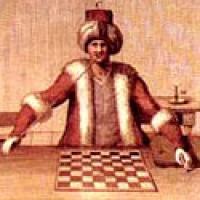
The automata Turkish
I’ve discovered a curious film Le joueur d’echecs where the Turkish appears on it, and I’ve extracted two very interesting fragments:
Von Kempelen presents the autòmata (3 min 26 seg)
Caterina II de Rússia VS The Turkish (4 min 35 seg)
Le joueur d’echecs (1926)
Directed by Raymond Bernard
Performers: Pierre Blanchar (Boleslas Vorowski), Charles Dullin (Von Kempelen), Edith, Jehanne (Sophie Novinska)
Music by Henri Rabaud
Length of the film: 1 h 35 min

Frames of the film
Synopsis: During a complicated time, the baron von Kempelen, the inventor of automatas, presents at the King Stanislas parliament of Polland and the Queen Caterina II of Russia, his latest creation: The Turkish, who was win Caterina at the end. Von Kempelen died in a tragic and lovely ending.
The automata “The Turkish”
The Hungarian engineer Wolfgang von Kempelen built The Turkish around the middle of the 18th century, a machine that played chess (predecessor of the Deep blue) that was able to win to the best players at that time.
The machine consisted of a Turkish figure in a real size, sitting before a box of 120 cm wide and 80 cm tall and on it there was a chessboard. The Turkish was articulated from the waist up, and it was able to do the movements of the pieces in an automatic way, obviously, a person was hidden inside the machine, which thought the moves and directed the movements.


Before each game, Kempelen showed the inner box, the pulleys and the gearings that moved the articulated limbs of the Turkish and also a complicated mechanism that supposedly gave the thought to the machine. As any professional illusionist of that time, Kempelen was also able to hide the man inside the machine.

Kempelen began offering 500 rubbles to the person who win the automata. After some years he had won a lot of money. The automata suppose a monumental shame at that time, even thought personally I think that it was a wonder of the science, the shrewdness, the imagination and the fraud. He had got guts and got a fortune that was really deserved.
Kempelen exhibited the Turkish for the first time to the Maria Teresa de Austria court in 1770 where it caused great sensation. Afterwards he toured through Europa during 1780 decade. Some famous personalities such Napoleon Bonaparte (*), Benjamin Franklin and Caterina II of Russia where impeccability expired by the Turkish. But individuals such Philidor or Federic II of Prusia had won to the automata.

Kempelen began offering 500 rubbles to the person who win the automata. After some years he had won a lot of money. The automata suppose a monumental shame at that time, even thought personally I think that it was a wonder of the science, the shrewdness, the imagination and the fraud. He had got guts and got a fortune that was really deserved.
Kempelen exhibited the Turkish for the first time to the Maria Teresa de Austria court in 1770 where it caused great sensation. Afterwards he toured through Europa during 1780 decade. Some famous personalities such Napoleon Bonaparte (*), Benjamin Franklin and Caterina II of Russia where impeccability expired by the Turkish. But individuals such Philidor or Federic II of Prusia had won to the automata.

During the Turkish history had passed different chess players inside it. The first one was the Polish officer Worowski, who was a good player and beside he had also two amputated legs, so it was very easy to hide him inside the box. Afterwards the place was taken up by J. Allgaier, a high level Austrian chess player who had the privilege to be very afraid the day that defied Napoleon. Finally, it was Schlumberger, a fat man, who once was caught into the box and when he desperately asked for help the Turkish secret was discovered. The mystery ended definitely with the publication of the article “The chess player of Maelzel” signed by Edgar Allan Poe, where it proved in a strict way that the automata had a man inside it.
After Kempelen died, the Turkish went from hand to hand to different persons and it ended at Philadelphia Museum where was destroyed in 1857 by fire. It was a pity.
(*) Game Napoleon Bonaparte vs the Turkish (took up by J. Allgaier)
Although it is said that Napoleon was a good chess player, with a good reputation
of good strategies in the game against the Turkish he didn’t get too much right answers.
of good strategies in the game against the Turkish he didn’t get too much right answers.
I highly recommend a good
novel whose plot revolves
around the story of the Turk:
by Robert Löhr



